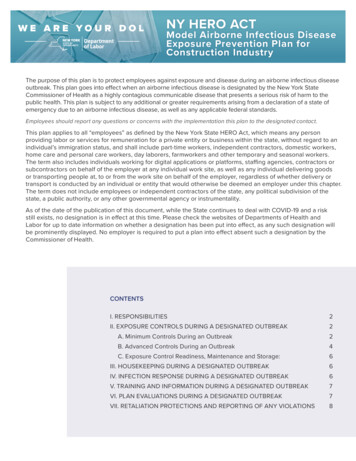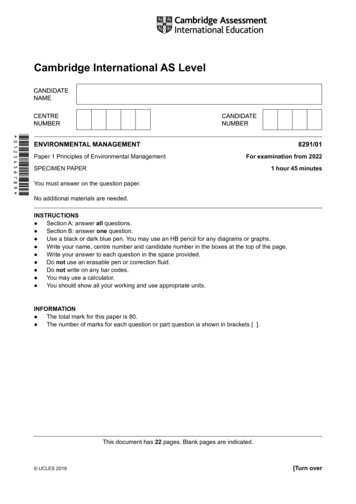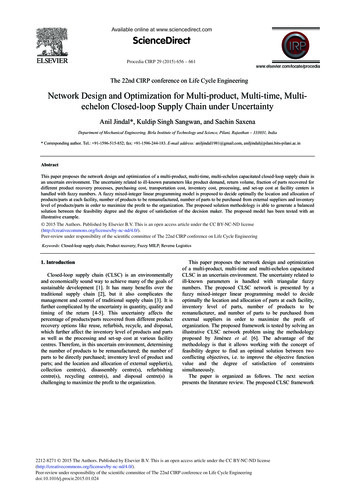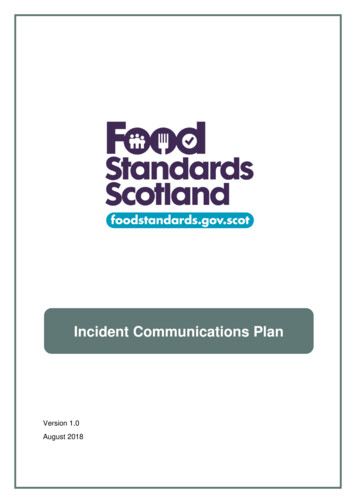
Transcription
Multi-country outbreak of monkeypoxExternal Situation Report 4, published 24 August 2022Data as received by WHO national authorities by 17:00 CEST, 22 August 2022Risk assessmentGlobal risk – ModerateWHO Regional risk European Region – High African Region, Region of the Americas, Eastern Mediterranean Region,Southeast Asia Region – Moderate Western Pacific Region – Low-ModerateLaboratoryconfirmedcases41 664Deaths12Countries/areas/territories96Highlights During the week of 15 to 21 August, the number of cases reported in the Region of the Americas shows acontinuing steep rise, confirming trends seen over the last several weeks. Globally, after four consecutiveweeks of increase, the number of monkeypox cases reported declined by 21% overall during the sameweek (n 5907 cases) as compared to the previous week (n 7477 cases). This decrease may reflect earlysigns of a declining case count in the European region, which would need to be subsequently confirmed.On 8 August, WHO convened a meeting of two WHO Collaborating Centres for orthopoxviruses and otherexperts in poxvirology and viral evolution to consider the naming of monkeypox virus (MPXV) variants.Henceforth, the Congo Basin or Central African clade will be referred to as Clade I; the West African cladewill be referred to as Clade II, with subclades IIa and IIb, the latter referring to the variant that ispredominant in the multi-country outbreak.WHO has updated the interim guidance on vaccines and immunization for monkeypox. Updates includea clearer emphasis on the groups at risk of monkeypox for consideration for preventive vaccination, andupdated terminology for pre- and post-exposure vaccination. To reduce confusion with the terms used inthe management of HIV, the changes include using primary preventive (pre-exposure) vaccination (PPV)rather than pre-exposure prophylaxis (PrEP), and post-exposure vaccination (PEPV) rather than postexposure prophylaxis (PEP).Page 1
Epidemiological UpdateFrom 1 January through 22 August 2022, 41 664 laboratory-confirmed cases of monkeypox and 12 deaths havebeen reported to WHO from 96 countries/territories/areas[i] in all six WHO Regions (Table 1). Since the last editionof this report published on 10 August 2022, 13 859 new cases (50% increase) and 1 new death were reported;and 7 new countries reported cases. In the past seven days, 23 countries reported an increase in the weeklynumber of cases, with the highest increase reported in the United States of America. There are 16 countries thathave not reported new cases for over 21 days, the maximum incubation period of the disease.The number of weekly new cases reported globally decreased by 21% in week 33 (15-21 August) (n 5907 cases)compared to week 32 (8 - 14 August) (n 5213 cases). The majority of cases reported in the past 4 weeks werenotified from the Region of the Americas (60.3%) and the European Region (38.7%).As of 22 August, the ten countries that have reported the highest cumulative number of cases globally are UnitedStates of America (n 14 049), Spain (n 6119), Brazil (n 3450), Germany (n 3295), The United Kingdom (n 3225), France (n 2889), Canada (n 1168), Netherlands (n 1090), Peru (n 937), and Portugal (n 810).Together, these countries account for 88.9% of the cases reported globally.In the past seven days, two countries reported their first case. These include Iran (Islamic Republic of) andIndonesia.Figure 1. Epidemiological curve of weekly aggregated confirmed cases of monkeypox by region, from 1 Januaryto 22 August 2022 17:00 CEST**This figure shows aggregated weekly data, for epidemiological weeks ending on Sundays. Data on the currentweek, with incomplete data, will be presented in the next situation report.Page 2
Table 1. Number of cumulative confirmed monkeypox cases and deaths reported to WHO, by WHO Region,from 1 January 2022 to 22 August 17:00 CESTWHO RegionAfrican RegionRegion of the AmericasEastern Mediterranean RegionEuropean RegionSouth-East Asia RegionWestern Pacific RegionCumulativeConfirmedcases40420 4383520 6521412141 664Deaths720201112Other key epidemiological findings: The outbreak continues to affect young people of male gender, with 98.2% (20 138/20 500) of cases withavailable data on the gender being males with a median age of 36 years (Interquartile range: 30-43 years).Fewer than 1% (140/23 626) of cases with age data available are aged 0-17 years. This proportion differsbetween countries, with those in West and Central Africa reporting a greater proportion of cases amongyoung age groups: 38.7% (65/168) of cases for whom age was available were among the age group 0-17,out of which 12.5% (21/168) were aged 0-4. Among cases with sexual orientation reported, 95.8% (9484/9899) identified as men who have sex withmen. Of all reported types of transmission, a sexual encounter was reported most commonly, with 5954of 7250 (82.1%) of all reported transmission events. The majority of cases were likely exposed in a party setting with sexual contacts, with 2204 of 3639(60.6%) of all likely exposure categories. Among cases with known HIV status, 45% (4501/10 036) are HIV positive.Infection among Health Care WorkersAs of 22 August 2022, a small proportion of cases have been reported among health workers (HW) (n 256; 5.2%of cases with information available on the route of transmission), however, most were infected in the communityand further investigation is ongoing to determine whether the remaining infection was due to occupationalexposure. Healthcare-associated infection (HAI) has been confirmed in three cases to date.For further information, please see the WHO Multi-country Monkeypox Outbreak – Global Trends.Page 3
Figure 3. Geographic distribution of confirmed cases of monkeypox reported to or identified by WHO from official public sources from 1 January 2022 to 22 August17:00 CESTPage 4
Updates and WHO AdviceWHO continues to closely monitor and respond to the outbreak and support international coordination andinformation sharing with the Member States and partners. Clinical and public health incident response have beenactivated by Member States to coordinate comprehensive case finding, contact tracing, laboratory investigation,supported isolation, clinical management, implementation of infection prevention and control measures, riskcommunication and community engagement, and vaccination activities, as well as support ongoingepidemiological and countermeasures research.Surveillance and LaboratoryWHO has updated the Monkeypox Case investigation form (CIF), as well as a minimum dataset Case reportingform (CRF), to include the latest information on symptomatology and epidemiological parameters, and to alignwith the Temporary Recommendations issued by the Director General, after the declaration of the Public HealthEmergency of International concern (PHEIC).Currently, WHO has received the CRF for around 90% of the total confirmed cases reported at the global level.The consistency and completeness of these data vary widely between countries, but overall the analysis of thecollected information in the global report provides a good view of the ongoing outbreak.WHO is piloting a systematic collection of information about the outbreak response implemented by countriesfor monkeypox through a Policy and Response Tracker, which includes information about surveillance, testing,isolation, quarantine and vaccination.On 8 August, WHO convened a meeting of two WHO Collaborating Centres for orthopoxviruses and other expertsin poxvirology and viral evolution to consider the nomenclature of monkeypox virus (MPXV) variants. Goingforward the Congo Basin or Central African clade will be referred to as Clade I; the West African clade will bereferred to as Clade II, with subclades IIa and IIb, the latter referring to the variant that is predominant in theglobal outbreak.Clinical management, vaccines and therapeuticsVaccinesWHO has updated the interim guidance on vaccines and immunization for monkeypox. Updates include a cleareremphasis on the groups at risk of monkeypox for consideration for preventive vaccination, and updatedterminology for pre- and post-exposure vaccination. To reduce confusion with the terms used in the preventionof HIV infection, the changes include using primary preventive (pre-exposure) vaccination (PPV) rather than preexposure prophylaxis (PrEP), and post-exposure vaccination (PEPV) rather than post-exposure prophylaxis (PEP). Theguidance emphasizes that the effectiveness of vaccination in the context of the current monkeypox outbreakremains uncertain. As before, WHO strongly encourages Member States to convene their national immunizationtechnical advisory groups (NITAGs) to review the emerging evidence and develop policy recommendations forPage 5
the use of vaccines as relevant to the national context, both to ensure readiness in countries where there are fewor no cases reported, as well as to support a timely response when required. It is recommended to implementvaccine efficacy studies during vaccine roll-out to document vaccine effectiveness and evaluate immunizationstrategies.Post-exposure vaccination (PEPV) is recommended for close contacts of cases, ideally within four days of firstexposure (and up to 14 days in the absence of symptoms), to prevent onset or mitigate severity of the disease.Primary preventive vaccination before exposure (PPV) is recommended for individuals at high risk of exposure(importantly but not exclusively gay, bisexual and other men who have sex with men and/or have multiple sexualpartners) and for health workers at high risk of exposure, laboratory personnel working with orthopoxviruses,clinical laboratory personnel performing diagnostic testing for monkeypox, and outbreak response teammembers (as designated by national public health authorities).Persons at risk of exposure and at higher risk of severe disease (e.g. immunocompromised persons, pregnantwomen, or children who are potential contacts or members of the same household as persons with monkeypox)should be offered vaccination with appropriate vaccine on a case-by-case basis. All decisions aroundimmunization of individuals with monkeypox or smallpox vaccines (before or following potential exposure)should be by shared clinical decision-making between the health care provider and prospective vaccinee, basedon a joint assessment of risks and benefits, on a case-by-case basis.Member States using vaccines against monkeypox are strongly encouraged to do so within a framework ofcollaborative clinical studies using standardized design methods and data collection tools for clinical and outcomedata, in order to rapidly increase evidence generation, especially on vaccine efficacy/effectiveness and safety.Where participation in placebo-controlled clinical efficacy trials for monkeypox vaccines and schedules is notconsidered feasible, the use of a range of other robust study designs to assess vaccine effectiveness should berapidly put in place employing standard data collection methods, where resources allow.TherapeuticsCaring for patients with suspected or confirmed monkeypox requires early recognition through screeningprotocols adapted to local settings, and rapid implementation of appropriate IPC measures (includingimplementation of transmission-based precautions and prompt isolation), testing to confirm diagnosis,symptomatic management of patients with mild or uncomplicated monkeypox and monitoring for and treatmentof complications and life-threatening conditions such as progression of skin lesions, severe pain, proctitis, urinaryretention, secondary bacterial infection of skin lesions, ocular lesions, and rarely, encephalitis, myocarditis and/ordeath. Patients with mild or uncomplicated monkeypox who isolate at home require careful assessment of theability to safely isolate and maintain required IPC precautions in their home to prevent transmission to otherhousehold and community members and have access to care if they progress or worsen. Precautions (isolationand IPC measures) should remain in place until lesions have crusted, scabs have fallen off and a fresh layer of skinhas formed underneath.To enable reliable evaluation of therapeutic interventions, randomized trials using CORE protocols are thepreferred approach. Unless there are compelling reasons not to do so, every effort should be made to implementrandomized trial design. It is feasible to conduct placebo-controlled studies, especially in individuals at low riskfor serious disease. Harmonised data collection for safety and clinical outcomes using the WHO Global ClinicalPlatform for monkeypox, would represent a desirable minimum dataset in the context of an outbreak, includingthe current event.Page 6
WHO is seeking feedback on the Target Product Profile (TPP) therapeutics for monkeypox cases from experts inthe industry, product developers, the scientific community, national infection control programme personnel andclinicians currently involved in the management and control of monkeypox. The TPP is intended to guide andprioritize the evaluation of repurposed therapeutic agents for monkeypox or the development of new therapeuticagents.Risk Communication and Community EngagementBalanced risk communication and community engagement approaches need to reach the most affectedpopulations. It is most effective to use existing trusted networks to reach those who identify as gay, bisexual ormen who have sex with men (MSM) and those with recent multiple sex partners. In most countries thesenetworks can be accessed by partnering with HIV/AIDS networks. Engagement efforts should include openquestions with detailed advice and answers, that present alternatives to high-risk activities which are codeveloped with affected population groups.Affected persons should be aware of emerging information and knowledge about symptoms and updatedbehavioural advice to avoid further spread of monkeypox. As vaccines, testing and therapeutics become moreavailable, communication with individuals on; 1) who should access these measures, 2) how they can be accessed,3) how they work, 4) the known limitations of specific measures, should be consistently communicated. Thisinformation should be shared through trusted channels, key influencers and community based and civil societyorganizations representing affected populations. Unknowns and nuances of vaccines, testing and therapeuticsshould be consistently and transparently shared with people receiving these.Page 7
Technical guidance and other resourcesWHO Guidance and Public Health Recommendations ance,24August2022. 61894/WHO-MPX-Immunization-2022.2-eng.pdfWHO Second meeting of the International Health Regulations (2005) (IHR) Emergency Committee regarding the multicountry outbreak of monkeypox, 23 July 2022. untry-outbreak-ofmonkeypoxWHO Director-General's statement at the press conference following IHR Emergency Committee regarding the multicountry outbreak of monkeypox, 23 July 2022. y-2022WHO Global clinical data platform for monkeypox case report form (CRF), 15 July PX-Clinical CRF-2022.2Public health advice for gatherings during the current monkeypox outbreak, 28 June PX-Gatherings-2022.1WHO Surveillance, case investigation and contact tracing for Monkeypox: Interim guidance, 24 June2022. POX-surveillance-2022.2Clinical management and infection prevention and control for monkeypox: Interim rapid response guidance, 10 June2022. inical-and-IPC-2022.1WHO Technical brief (interim) and priority actions: enhancing readiness for monkeypox in WHO South-East Asia Region,7 July 2022. o/whe/monkeypox/searo-mpx-tbrief22.pdfData management The WHO Global Clinical Platform for monkeypox, 14 June 2022. ereportform(CRF),14June2022. inical-CRF-2022.1Case and contact investigation form (CIF), 16 June 2022. inimum-dataset-case-reporting-form-(crf)WHO Go.Data: Managing complex data in outbreaks. https://www.who.int/tools/godataMonkeypox Case investigation form (CIF) and minimum dataset Case reporting form k communication and community engagement Monkeypox Q&A, 23 August 2022. xRisk communication and community engagement (RCCE) for monkeypox outbreaks: Interim guidance, 24 June PX-RCCE-2022.1Interim advice for public health authorities on summer events during the monkeypox outbreak in Europe, 2022. 14 June2022. -2022Interim advice on Risk Communication and Community Engagement during the monkeypox outbreak in Europe, 2June2022.https://www.euro.who.int/ data/assets/pdf eypox-2-062022-eng.pdfWHO Monkeypox outbreak: update and advice for health workers, 26 May 2022. e/risk-comms-updates/update monkeypox-.pdf?sfvrsn 99baeb03 1Monkeypox: public health advice for gay, bisexual and other men who have sex with men, 18 July h-menPage 8
Risk communication and community engagement. Public health advice on the recent outbreak of monkeypox in the WHOEuropean Region, 24 May 2022. https://www.euro.who.int/ data/assets/pdf .pdfLaboratory and diagnostics idance,23May2022. https://apps.who.int/iris/handle/10665/354488WHO Guidance on regulations for the transport of infectious substances 2021-2023, 25 February2021. 720Genomic epidemiology of monkeypox virus. https://nextstrain.org/monkeypox?c countryMonkeypox: experts give virus variants new names, 12 August 2022. -experts-give-virus-variants-new-namesDisease Outbreak News and situation reports Monkeypox outbreak 2022: st-2022WHO Multi-country outbreak of monkeypox, External situation report #2 – 25 July -report--2---25july-2022WHO Multi-country outbreak of monkeypox, External situation report #1 - 6 July eypox,allitemsrelatedtomulti-countryoutbreak: tem/2022-e000121WHO disease outbreak news: Monkeypox, all previous items including endemic countries and traveler-associatedoutbreaks: tem/monkeypoxTraining and Education WHO monkeypox outbreak toolbox, June 2022. xWHO factsheet on monkeypox, 19 May 2022. nkeypoxHealth topics – Monkeypox: https://www.who.int/health-topics/monkeypoxOpen WHO. Online training module. Monkeypox: Introduction. 2020English: Français: ductionOpen WHO. Extended training. Monkeypox epidemiology, preparedness and response. 2021.English: ;Français: mediaireOther Resources WHO AFRO Weekly Bulletin on Outbreaks and Other Emergencies, all previous items: reaks/outbreaks-and-other-emergencies-updatesWHO 5 moments for hand hygiene. ayWHO One Health. https://www.who.int/health-topics/one-healthWorld Organisation for Animal Health, founded as OIE: Monkeypox. https://www.woah.org/en/disease/monkeypox/Joint WHO Regional Office for Europe - European Centre for Disease Prevention and Control, Monkeypox surveillancebulletin Situation reports (who.int)Page 9
Joint WHO Regional Office for Europe - European Centre for Disease Prevention and Control, Monkeypox Resource toolkitto support national authorities and event organizers in their planning and coordination of mass and large gatheringevents. on-ofmass-and-large-gathering-events/WHO European Region Interim advice for public health authorities on summer events during the monkeypox outbreak inEurope, 2022 -2022Weekly epidemiological record (WER) no.11, 16 March 2018, Emergence of monkeypox in West Africa and Central Africa19702017. 0497/WER9311.pdf;jsessionid 7AB72F28D04CFE6CE24996192FC478FF?sequence 1 Jezek Z., Fenner F.: Human Monkeypox. Monogr Virol. Basel, Karger, 1988, vol 17, pp 1-5. doi:10.1159/isbn.978-3-318-04039-5Annex 1: Data, table and figure notesCaution must be taken when interpreting all data presented. Differences are to be expected between informationproducts published by WHO, national public health authorities, and other sources using different inclusion criteriaand different data cut-off times. While steps are taken to ensure accuracy and reliability, all data are subject tocontinuous verification and change. Case detection, definitions, testing strategies, reporting practice, and lagtimes differ between countries/territories/areas. These factors, amongst others, influence the counts presented,with variable underestimation of true case and death counts, and variable delays to reflecting these data at theglobal level.[i]‘Countries’ may refer to countries, territories, areas or other jurisdictions of similar status. The designationsemployed, and the presentation of these materials do not imply the expression of any opinion whatsoever onthe part of WHO concerning the legal status of any country, territory, or area or of its authorities, or concerningthe delimitation of its frontiers or boundaries.Annex 2: Confirmed cases of monkeypox by WHO region and country from 1 January 2022 to22 August 2022, 17:00 CEST*WHO RegionAfrican onCentral African RepublicCongoDemocratic Republic of the CongoGhanaLiberiaNigeriaSouth AfricaIran (Islamic Republic of)LebanonMoroccoQatarSaudi ArabiaSudanUnited Arab EmiratesPage ths0020010400000000
EuropeanRegionRegion of theAmericasAndorraAustriaBelgiumBosnia and olandPortugalRepublic of TürkiyeRepublic of MoldovaRomaniaRussian landThe United KingdomArgentinaBahamasPage 00000000000000000000000000000000000200000
South-EastAsia RegionWesternPacific RegionCumulativeBarbadosBermudaBolivia (Plurinational State of)BrazilCanadaChileColombiaCosta RicaCuraçaoDominican artiniqueMexicoPanamaPeruPuerto RicoSaint MartinUnited States of AmericaUruguayVenezuela (Bolivarian Republic of)IndiaIndonesiaThailandAustraliaChinaJapanNew CaledoniaNew ZealandPhilippinesRepublic of KoreaSingapore96 countries/territories/areasPage 121137345011681891643161914341252493766114 04921914893414411541 6640001000000100000000000001000000000012
1 day ago










